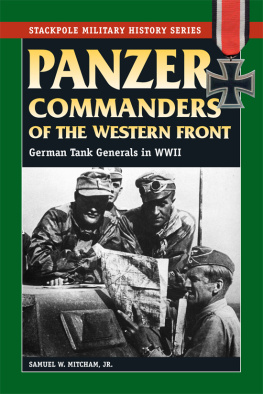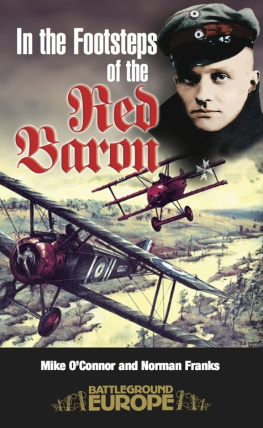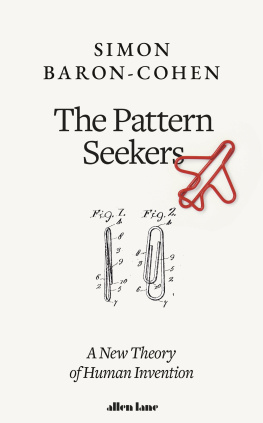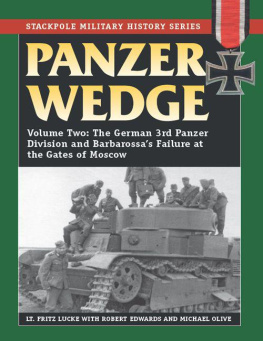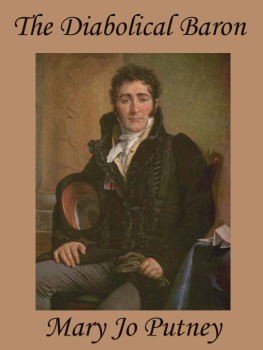APPENDIX A
Table of Comparative Ranks
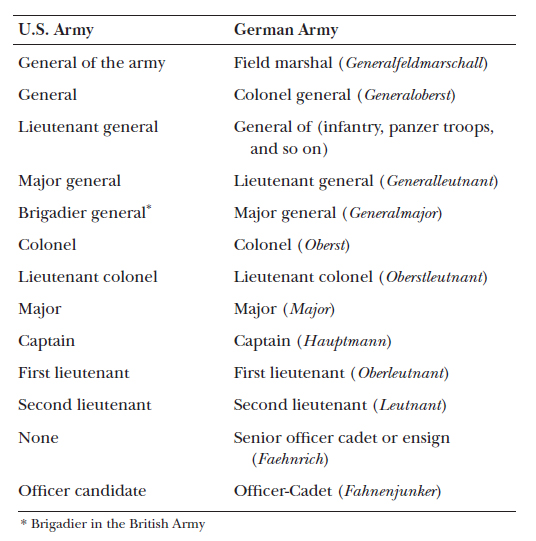
APPENDIX B
German Staff Positions
in World War II
Chief of staff (Not present below the corps level)
| Ia. | Chief of operations |
| Ib. | Quartermaster (chief supply officer) |
| Ic. | Staff officer, intelligence (subordinate to Ia) |
| IIa. | Chief personnel officer (adjutant) |
| IIb. | Second personnel officer (subordinate to IIa) |
| III. | Chief judge advocate (subordinate to IIa) |
| IVa. | Chief administrative officer (subordinate to Ib) |
| IVb. | Chief medical officer (subordinate to Ib) |
| IVc. | Chief veterinary officer (subordinate to Ib) |
| IVd. | Chaplain (subordinate to IIa) |
| V. | Motor transport officer (subordinate to Ib) |
National socialist guidance officer (added in 1944) |
Special staff officers: chief of artillery, chief of projectors (rocket launchers), and so on |
APPENDIX C
Characteristics of Selected
World War II Tanks
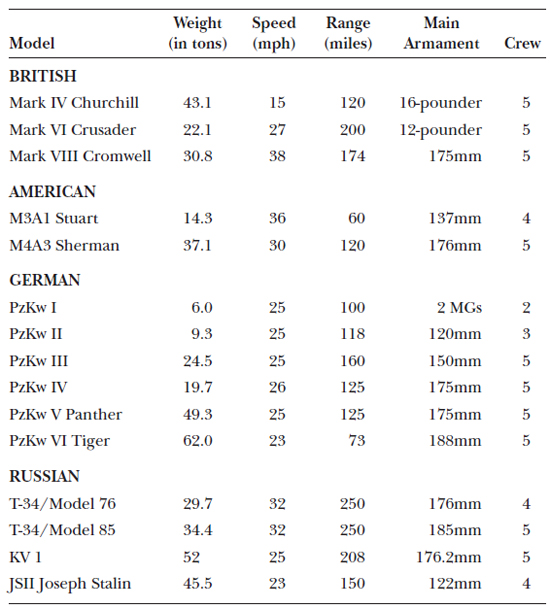
Bibliography
Bradley, Dermot, Karl-Friedrich Hildebrand, and Marcus Roevekamp. Die Generale des Heeres, 1921 1945 . Osnabrueck, Germany: Biblio, 1993. 7 vols. to date.
Carell, Paul [Paul Carl Schmidt]. The Foxes of the Desert . Mervyn Savill, trans. London: Macdonald, 1960.
_____. Hitler Moves East . Ewald Osers, trans. Boston: Little, Brown, 1964.
_____. Invasion: Theyre Coming . Ewald Osers, trans. London: Harrap, 1962.
_____. Scorched Earth . Ewald Osers, trans. London: Harrap, 1970.
Cole, Hugh M. The Lorraine Campaign . Washington, DC: Historical Division, Department of the Army, 1950.
Eberbach, Hans. Panzer Group Eberbach and the Falaise Encirclement. Foreign
Military Studies MS #A-922. Historical Division, U.S. Army, Europe.
Franz, Gerhard. British interrogation of Maj. Gen. Gerhard Franz. On file at the Air University Archives, Montgomery, Alabama.
Guderian, Heinz. Panzer Leader . London: M. Joseph, 1952.
Hart, B. H. Liddell. The Other Side of the Hill . London: Cassell, 1948.
Hoth, Hermann. Panzer Operationen . Heidelberg, Germany: K. Vowinckel, 1956.
Jollasse, Erwin. 9th Panzer Division (24 JULY4 SEP 1944). Foreign Military Studies MS #B-837. Historical Division, U.S. Army, Europe.
Keegan, John. Six Armies in Normandy . New York: Penguin Books, 1983.
Keilig, Wolf. Die Generale des Heeres . Friedberg, Germany: Podzun-Pallas-Verlag, 1983.
Kurowski, Franz. Die Panzer Lehr Division . Bad Nauheim, Germany: Podzun-Verlag, 1964.
Kursietis, Andris J. Wehrmacht at War: The Units and Commanders of the German Ground Forces During World War II. Soesterberg, The Netherlands: Aspekt, 1999.
Luck, Hans von. Panzer Commander . New York: Praeger, 1989.
Luettwitz, Heinrich. XLVII Panzer CorpsArdennes. Foreign Military Studies MS #A-938. Historical Division, U.S. Army, Europe.
_____. The Assignment of the XLVII Panzer Corps in the Ardennes, 194445. Foreign Military Studies MS #A-939. Historical Division, U.S. Army, Europe.
_____. XLVII Panzer Corps in the Ardennes Offensive, Foreign Military Studies MS #940. Historical Division, U.S. Army, Europe.
Manstein, Erich von. Lost Victories . Novato, CA: Presidio, 1982.
Marshall, S. L. A. Bastogne: The First Eight Days . Washington, DC: Infantry Journal Press, 1946.
McKee, Alexander. Caen: Anvil of Victory . London: Pan, 1966.
Mellenthin, F. W. Panzer Battles: A Study in the Employment of Armor in the Second World War . Anthony G. Powell, trans. Novato, CA: Presidio, 1982.
Mitcham, Samuel W., Jr. Rommels Lieutenants . Westport, CT: Greenwood Press, 2006.
_____. Rommels Desert Commanders . Westport, CT: Greenwood Press, 2007.
Nafziger, George F. The German Order of Battle: Infantry in World War II . London: Greenhill Books, 2000.
Ritgen, Helmut. Die Geschichte der Panzer-Lehr-Division im Westen, 1944 1945 . Stuttgart, Germany: Motorbuch-Verlag, 1979.
Rommel, Erwin. The Rommel Papers . B. H. Liddell Hart, ed. New York: Harcourt, Brace, 1953.
Shulman, Milton. Defeat in the West . London: Secker and Warburg, 1947.
Speidel, Hans. Invasion 1944: Rommel and the Normandy Campaign . Chicago: Regnery, 1950.
Stauffenberg, Friedrich von. Papers. Unpublished papers in possession of the author.
Tessin, Georg. Verbaende and Truppen der deutschen Wehrmacht und Waffen-SS im Zweiten Weltkrieg, 1939 1945 . Osnabrueck, Germany: Biblio-Verlag, 197380.
U.S. Army Historical Division, U.S. Army, Europe. Guide to Foreign Military Studies, 1945 . 1954.
U.S. Army Military Intelligence Division. The German Replacement Army (Ersatzheer). 1945. U.S. War Department.
Westphal, Siegfried. German Army in the West . London: Cassell, 1951.
Wilmot, Chester. Struggle for Europe . New York: Harper, 1952.
Young, Desmond. Rommel: The Desert Fox . London: Collins, 1950.
CHAPTER 1
Baron Hans von Funck
T he family von Funck originated in East Prussia, probably as descendants of the Teutonic Knights who conquered the region in the twelfth century. Their earliest known ancestor flourished around the year 1355. The first Freiherr (Baron) von Funck was an official of the Prussian monarchy who died in 1643. One of Hans von Funcks later ancestors, Baron Carl von Funck, fought against Napoleon, rose to the rank of major general, and was killed in action during the battle of Leipzig in 1813.
Hanss father, Carl (18511913), was a Royal Prussian administrative official who ran a large rural district contiguous to his state near Aachen. He married Marie von Luetzow in 1887 and had two sons. Baron Albrecht von Funck, the older brother of the future panzer general, was born at Aachen on October 25, 1889. He entered the army in 1908, fought in the First World War, won the coveted Erinritter of the Order of St. John in 1917, and continued service under the Reichswehr through 1939, by which time he was a lieutenant colonel on the staff of the German ambassador to Belgrade. He later served as part of the occupation government in Yugoslavia, was captured by Titos partisans at the end of the war, and died a colonel in a prison compound on October 17, 1945. He and his wife, Freifrau (Baroness) Lonnie von Gultlingen, had no children.
Baron Hans Emil Richard von Funck was born at the family estate on December 23, 1891, and grew to be a large, well-built youth. He was educated at the usual schools in nearby Elbing. His mother died in 1902, and his father subsequently remarried prior to his death in 1913.
Being orphaned at the age of twenty-three prompted Hans to volunteer for the armyhe was urged on by his brother, already a Leutnant (second lieutenant), at the outbreak of World War I in August 1914 (see Appendix A for a Table of Comparative Ranks). On October 11, the younger Funck took the field with the 2nd Dragoon Regiment, serving in one of the hard-pressed divisions facing the Russian onslaught in the east.
Tangentially involved in the victory of Tannenberg, Hanss regiment engaged in the pursuit of the retreating enemy, and he was awarded the Iron Cross, 2nd Class, in late 1914. On June 15, 1915, he was patented as a second lieutenant, retroactive to December 19, 1913, and continued as a platoon commander with the dragoons.

